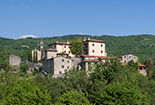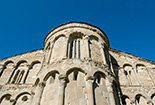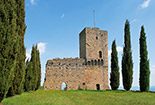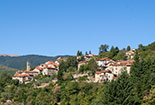Salutio and its beautiful parish church
in Casentino, a Tuscan valley with which you can get familiar in every detail through this site
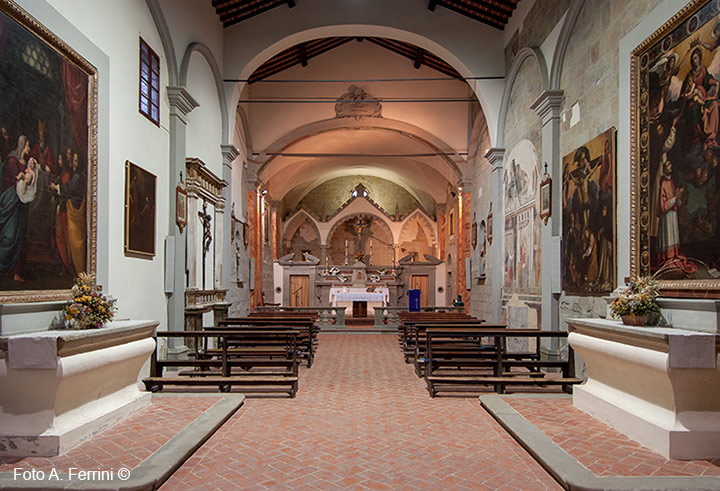
Texts and photos by Alessandro Ferrini ©
40 immagini in sequenza di Salutio e la sia pieve accuratamente descritte. Clicca per ingrandire
Salutio, a small village with a large parish church
 On the road Valdarno Casentino that connects Rassina and Talla there is the village of Salutio. The place has been remembered since the beginning of the XII century for the presence of a castle that from the second half of the XIV century, with the dominion of the Republic of Florence, lost importance, power and also the defensive walls just for the will of the Florentines so that it could not become a protected place for their enemies. Over the centuries the castle became more and more a stately palace surrounded by other houses and was the residence of the noble family Teri. The place is still called Castle and is located high above the village.
On the road Valdarno Casentino that connects Rassina and Talla there is the village of Salutio. The place has been remembered since the beginning of the XII century for the presence of a castle that from the second half of the XIV century, with the dominion of the Republic of Florence, lost importance, power and also the defensive walls just for the will of the Florentines so that it could not become a protected place for their enemies. Over the centuries the castle became more and more a stately palace surrounded by other houses and was the residence of the noble family Teri. The place is still called Castle and is located high above the village.
The presence of a castle had to correspond to a parish church. In the 13th century, the church was almost completely rebuilt and assumed its present size and shape. The church is dedicated to Sant'Eleuterio, from which the name of Salutio seems to derive. The first evidence of its existence dates back to 1027 when it was mentioned in the Regesto of Camaldoli. However, one can suppose that its origins are even more ancient.
The interior of the church has a single rectangular hall simple and essential. A particular architectural feature of the church is the total absence of the apse. The wall behind the high altar is perfectly straight, which is anomalous for a church of a certain level as this parish church undoubtedly was. Looking at the wall from the outside you can clearly see that it is its original shape. In fact, in the lower part of the wall you can clearly see the continuity of the large perfectly squared stones from the thirteenth century. Another evident evidence is the presence on the wall of two single lancet windows in Romanesque style.
Entering the church, the particular architecture behind the high altar is striking. This was originally the structure of the fourteenth century that was a chapel created for the fresco of the Annunciation by Mariotto di Cristofano. In 1844 this architectural element was removed from there by the parish priest Giovan Battista Porcellotti and used to create the central part of that architectural decoration now placed behind the altar.
The parish church is a real feather in the cap for the small town. Not so much for its architecture, which is very simple, but for the valuable works of art that are preserved there. First of all, we must mention a fresco dating back to the late twenties of the fifteenth century attributed to the Waldensian painter Mariotto di Cristofano. The work is divided into two scenes: above shows St. Francis receiving the Stigmata, below is painted the Annunciation with Saints Peter and Paul. The other works that decorate the church are made on canvas and belong to the first half of the seventeenth century. They were commissioned by the parish priest Tero Teri who could count on good economic availability as it belonged to the noble and rich Teri family mentioned above as the owner of that great palace, former castle. The works are: a Madonna of the Rosary and a Trinity by the painter from Montevarchi Michelangelo Vestrucci, a Presentation of Jesus in the Temple by Tommaso Gorini, an Annunciation attributed to the Florentine painter Simone Pignoni. A beautiful wooden crucifix is present in the church. It dates back to the end of the 17th century.
The baptismal font is very interesting. It consists of a base obtained from an ancient column at the top of which there is a stone basin surmounted by a wooden roof. This is still original in structure and pictorial decoration that can be dated sixteenth century. With regard to the stone basin is difficult to understand when it was built, you can assume shortly after the construction of the church. Near the baptismal font there is a small but pleasant organ dating back to the beginning of the 18th century.
Near the baptismal font there is a small but pleasant organ dating back to the beginning of the 18th century.
Returning to the village of Salutio, the oldest part of this is located, quite steeply, between the church and the road that leads from Casentino in Valdarno through the Crocina Pass. Two kilometers from the village is Santa Maria del Bagno, the place was once a convent, today is a seat scout. The church is pleasant and elegant, its entrance is located under a small loggia that served as a shelter for travelers and pilgrims who passed by there.
The church of Salutio is generally closed. To visit the church, please contact it:
Marinella, 0575.592483
Tiziana, 0575.1840957
Marisa, 0575.1941815



